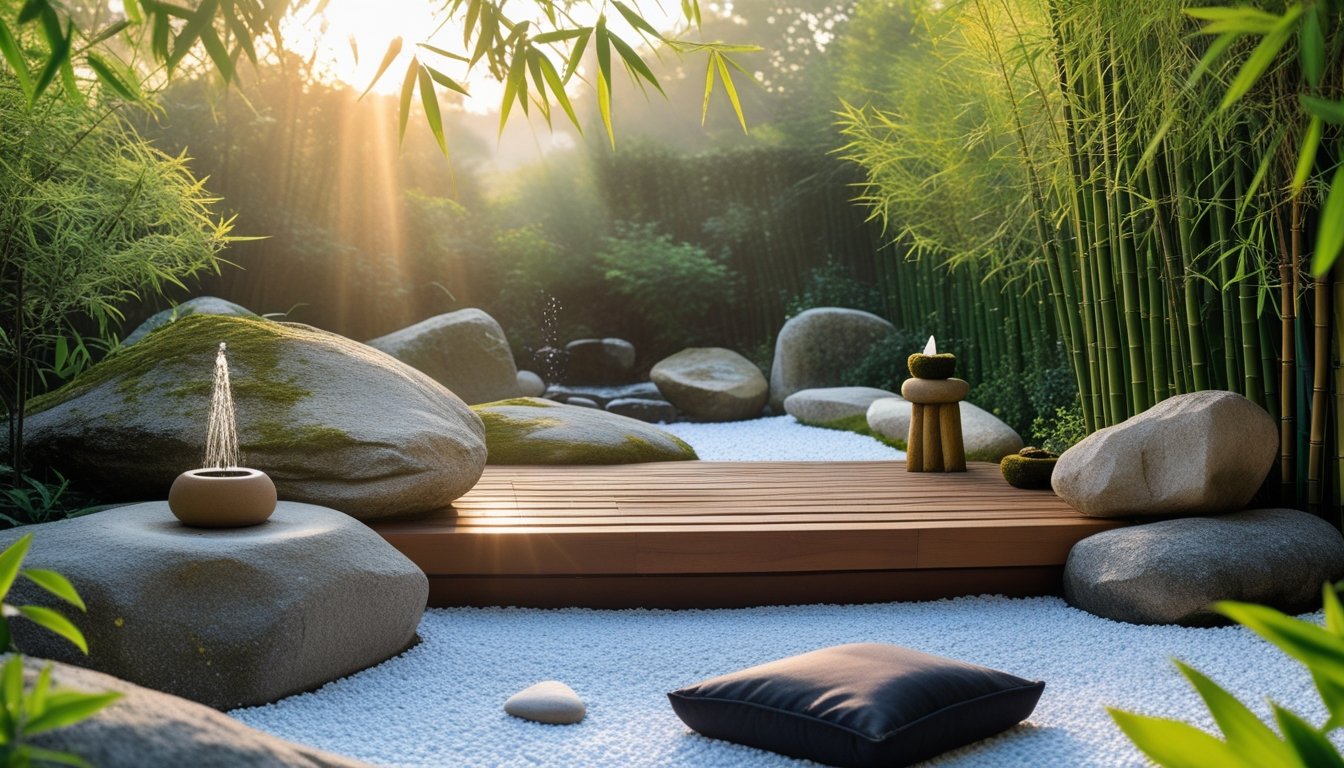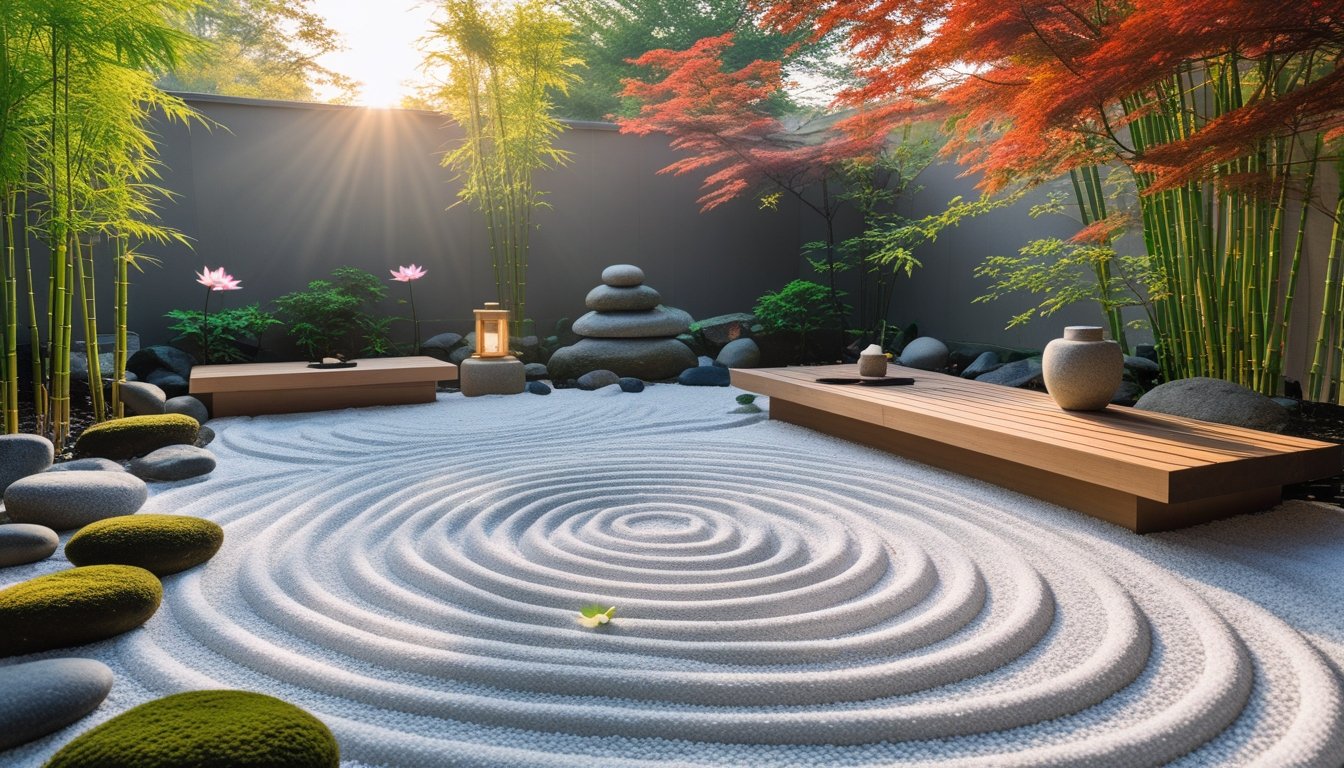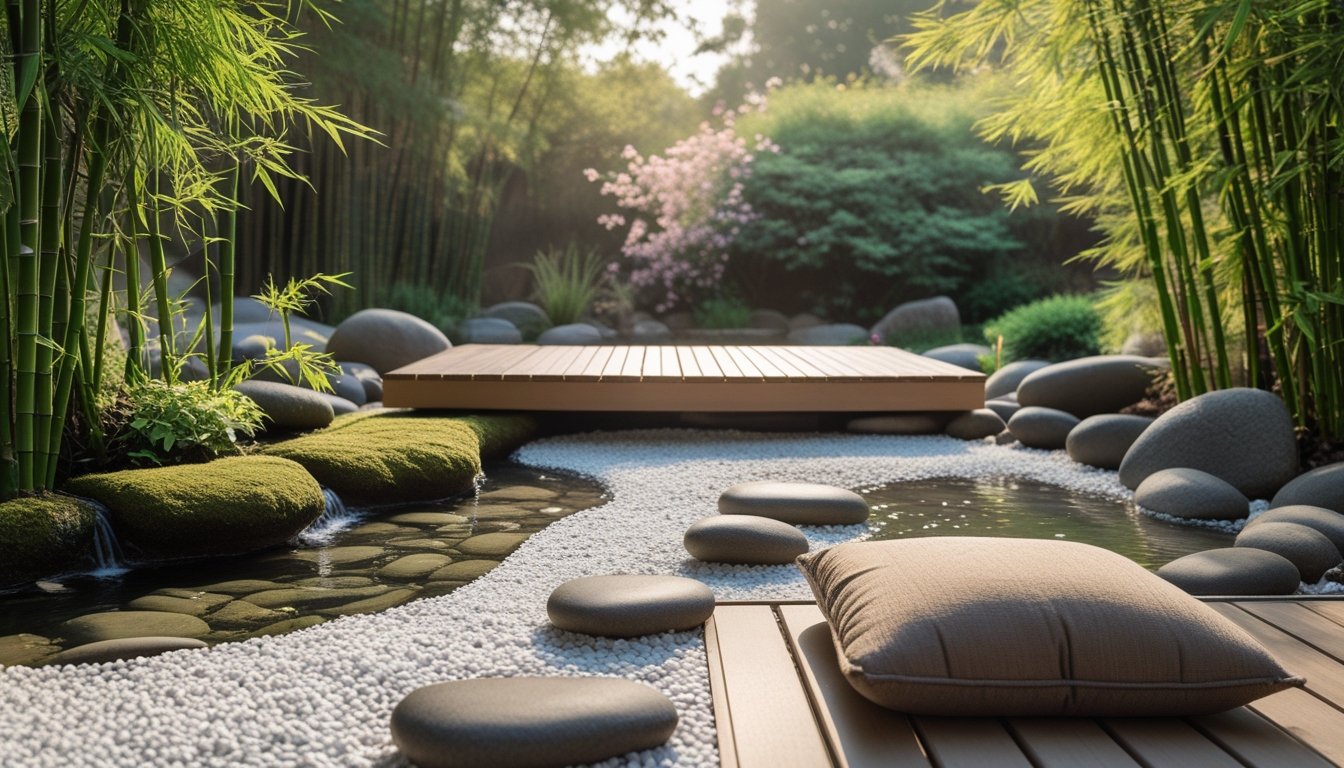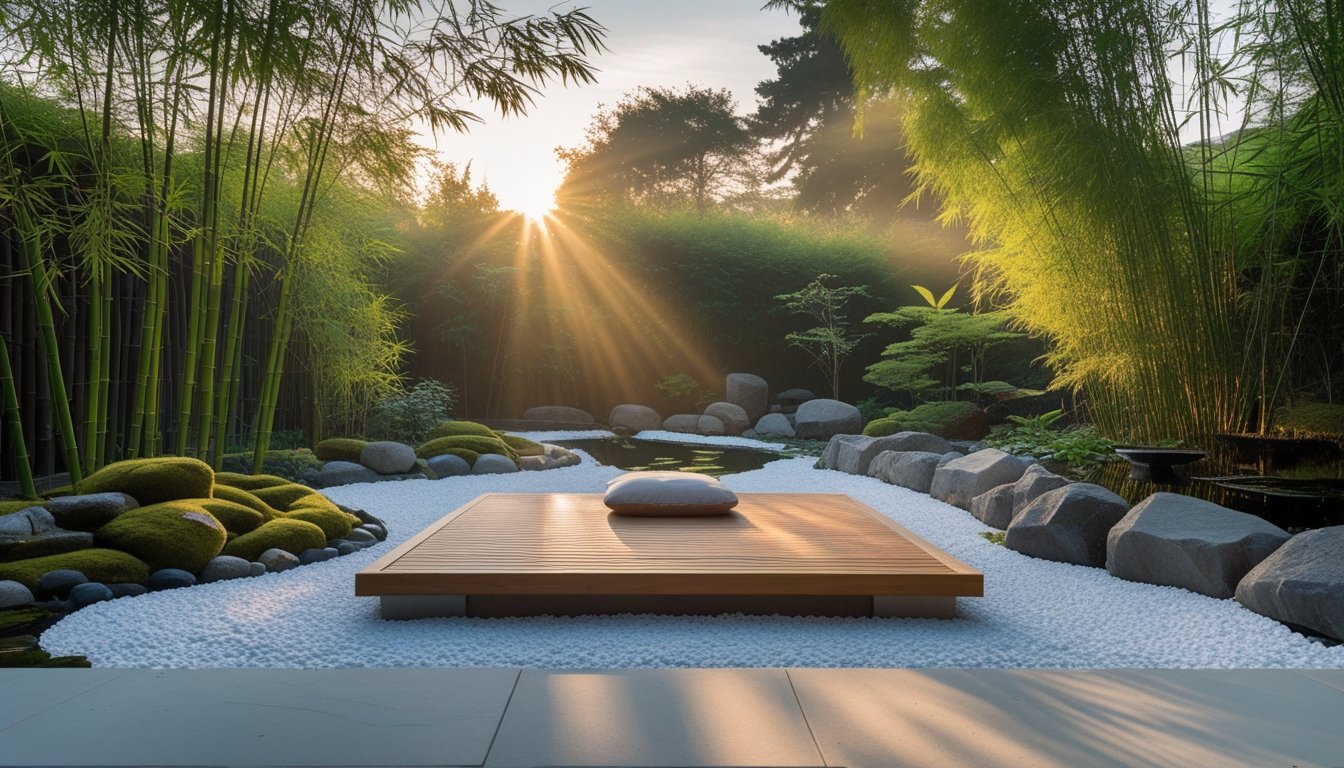Late updated: 14 Aug 2025 08:08
Written by: James Whitaker
Designing A Tranquil Outdoor Zen Meditation Spot: Creating Peaceful Spaces
Creating a peaceful and calming outdoor Zen meditation spot is a rewarding journey that reconnects us with nature and ourselves. By integrating elements like natural light, plants, and serene water features, we can craft an environment that radiates relaxation and tranquillity. As we immerse ourselves in the simple beauty of these spaces, we find a unique way to unwind and practise mindfulness right at home.

The essence of a Zen meditation garden is in its ability to foster a quiet mind and peaceful heart. By choosing the right spot, away from the noise and distractions, we can build a sanctuary where the outside world fades and introspection thrives. With an emphasis on balance and harmony, every feature from gravel patterns to seating arrangements serves to enhance the meditative experience.
Whether our space is a sprawling garden or a compact patio, the principles of design remain the same. The serenity of a dedicated outdoor area can transform not just our surroundings but also our state of mind, encouraging relaxation and inner peace. As we explore various ideas and styles, we open ourselves to a world of relaxation, finding tranquillity and calmness amid the hustle of daily life.
Key Takeaways
- Integrate natural elements for a serene meditation spot.
- Choose a secluded location to enhance introspection.
- Design principles focus on balance and harmony.
Core Principles of Zen Meditation Garden Design

In creating a Zen meditation garden, we focus on simplicity, balance, and harmony. Embracing these principles allows us to craft a serene retreat that fosters mindfulness and inner peace.
Embracing Simplicity and Minimalism
Simplicity and minimalism define the essence of Zen gardens. By reducing clutter and embracing minimal design, we create a tranquil oasis that encourages reflection and calm. Utilising materials like gravel, stone, and sand is crucial, as they are natural yet versatile.
Each element should serve a purpose; nothing is superfluous. Simplicity in design promotes mindfulness. It directs our focus towards serenity rather than distraction. This minimalist approach reflects the core values of Zen Buddhism, where less truly is more. By adhering to this principle, we can transform any outdoor space into a serene haven.
Finding Balance and Asymmetry
Zen garden design often incorporates asymmetry to achieve balance. While symmetry suggests arranged order, asymmetry promotes organic harmony. We blend seemingly disparate elements to create a soothing environment. These contrasts can lead to an aesthetic balance that is visually and spiritually satisfying.
Arranging rocks, plants, and water features with deliberate asymmetry invites contemplation. This balance fosters a deeper connection to nature and encourages reflection. Asymmetry teaches us to find peace in imperfection, aligning with the Zen philosophy of accepting life’s natural flow. Through this design principle, our garden becomes a place of inner tranquillity.
Blending Natural Elements for Harmony
Integrating natural elements is essential for achieving harmony in a Zen garden. We use materials like wood, stone, and flowing water to craft an environment that feels both serene and connected to the earth. Plants, including bamboo and moss, add a layer of tranquillity.
Each element complements the others, creating a holistic space. Water features, like ponds or streams, introduce movement and sound, enhancing mindfulness. Stones signify strength and stability, grounding us in the present. By blending these elements thoughtfully, we foster an atmosphere conducive to meditation, transformation, and inner peace. Through our thoughtful design, the Zen garden becomes a living embodiment of harmony.
Essential Features for a Tranquil Outdoor Zen Meditation Spot

Creating a Zen meditation spot requires attention to elements such as natural textures and soothing water features. Integrating greenery and ensuring a comfortable layout provides the setting for relaxation and mindful practices.
Selecting and Arranging Rocks, Gravel, and Sand
The first step in designing a Zen garden involves the careful selection of rocks, gravel, and sand. These materials form the backbone of a soothing landscape. Using gravel paths or raked sand can evoke flowing water or waves, encouraging a focus on mindfulness.
Incorporating stepping stones through gravel paths provides direction and structure. Rocks and stones add texture and can be placed strategically to create balance. Creating a rock garden with various sizes of stones helps integrate natural textures into our space, enhancing the meditative experience.
Incorporating Water Features and Ponds
Water features introduce movement and sound, adding to the tranquillity. Ponds or small fountains are popular choices. The gentle trickle of a fountain or the presence of a koi pond can create an atmosphere conducive to relaxation.
Lighting, particularly near water, is essential to accentuate these features. Ambient lighting or solar-powered lanterns around a pond can make evening meditations magical. Solar-powered lanterns are environmentally friendly and maintain an eco-conscious approach to design.
Designing with Greenery and Low-Maintenance Plants
Incorporating greenery elevates the Zen garden's calming effect. Placing moss between stepping stones or using ferns adds softness. Bamboo and evergreens are suitable due to their resilience and low maintenance. Bonsai trees or cherry blossoms can be elegant focal points.
Choosing plants like lavender or jasmine infuses the space with calming scents, enhancing the sensory experience. Arranging the greenery strategically allows for a seamless integration with other elements, ensuring we maintain a balanced aesthetic.
Comfortable Seating and Mindful Layouts
Comfortable seating is crucial. Options include meditation cushions like a zafu, stuffed with buckwheat hulls, or floor cushions. These promote the necessary posture for meditation. Adding a yoga mat is beneficial for versatility, catering to different mindfulness practices.
Seating arrangements should face the focal points of the garden, such as water features or carefully arranged stones. Placing pergolas can create shaded spaces, adding to comfort. Our layout should invite meditation and contemplation, ensuring this outdoor meditation space becomes a sanctuary for calm and reflection.
Frequently Asked Questions

Designing a tranquil outdoor Zen meditation spot involves focusing on essential elements, creating a sense of privacy, and carefully selecting plants and features that enhance tranquillity. Budget-conscious choices and proper selection of meditation cushions also play a significant role.
What are essential elements to include in a meditation garden?
In crafting a meditation garden, the use of natural elements like stones, water features, and gravel is vital. These components encourage mindfulness and reflection. Soft, ambient lighting can create a soothing atmosphere, making the space inviting both during the day and at night.
How can one create a sense of privacy in a small outdoor meditation area?
Privacy can be achieved with the strategic placement of fences, tall plants, or bamboo screens. The use of these elements can help create a sense of seclusion even in small spaces, allowing us to fully immerse ourselves in meditation without external distractions.
What are suitable plants for cultivating a serene meditation space?
Opting for plants like bamboo, lavender, or ferns can enhance the serene atmosphere. These plants are not only aesthetically pleasing but also thrive well in various climates, making them a wise choice for any meditation garden. Their presence can contribute to a natural and harmonious setting.
Which features can enhance the tranquillity of a backyard meditation spot?
Incorporating features such as a small water fountain or a Zen sand garden can significantly elevate the sense of peace. These elements add movement and sound, promoting a calming rhythm to meditation. Their gentle presence helps in creating an ideal backdrop for inner reflection.
How can I design a meditation garden on a budget?
Creating a meditation garden need not be costly. Reusing materials, such as old stones or recycled wood, can keep costs down. Native plants often require less upkeep and expense, making them a smart choice. DIY projects, like building your own water feature, can also be fun and affordable.
What considerations should be made for selecting outdoor meditation cushions?
When choosing outdoor meditation cushions, we must consider weather-resistant materials and comfort. Look for cushions made from durable fabrics that can withstand the elements, like sun and rain. Ensuring the cushion provides sufficient support can enhance the meditation experience, allowing for longer and more comfortable sessions.
